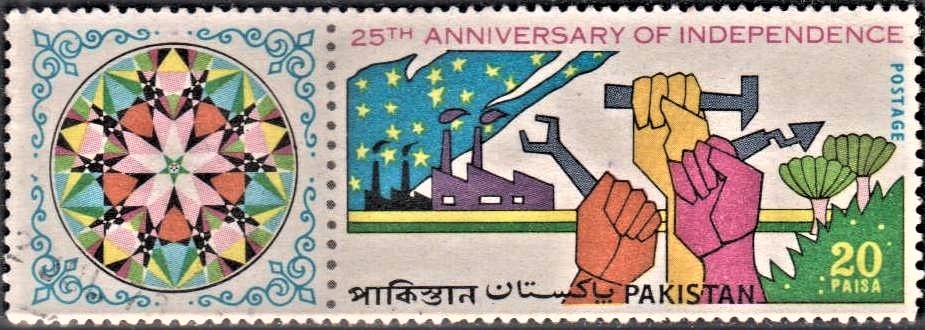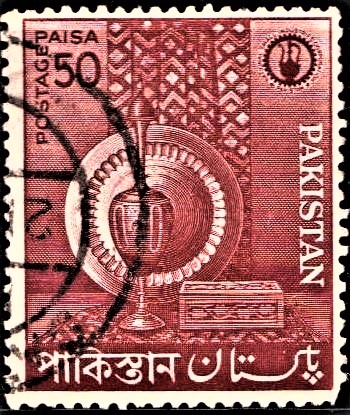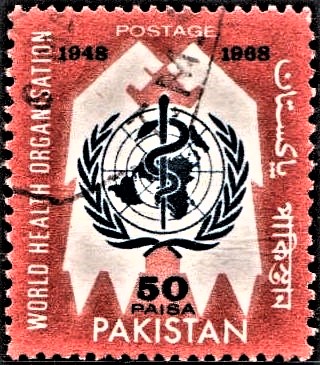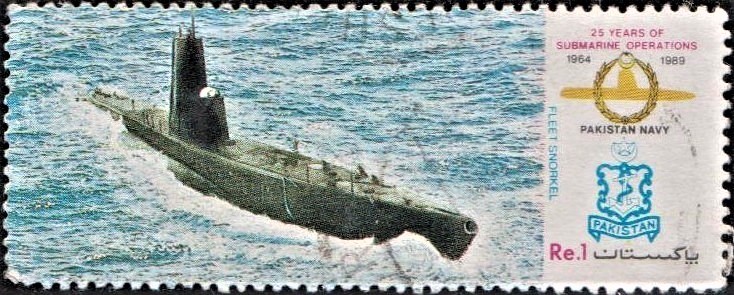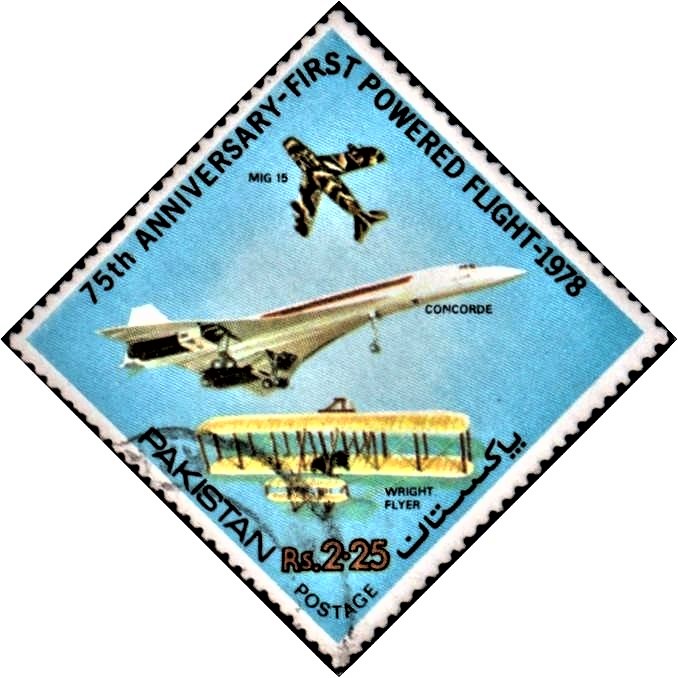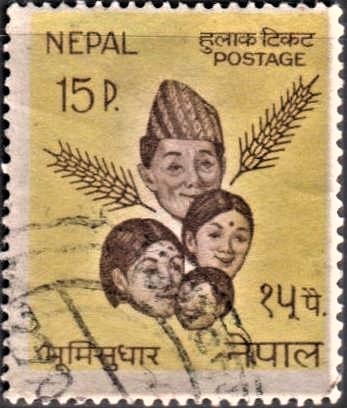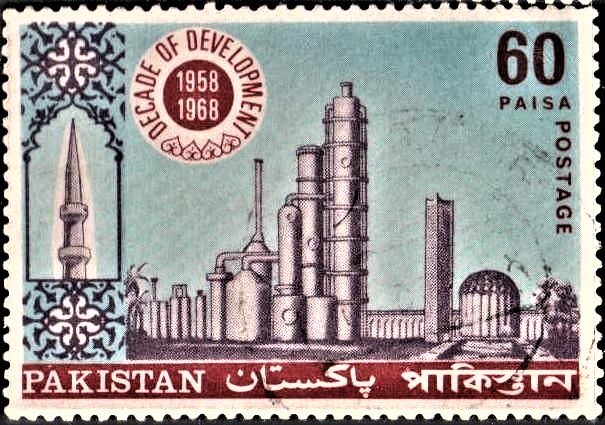
Pakistan on Decade of Development 1958-1968
Complete set of 4 nos. of commemorative postage stamp on the Decade of Development 1958–1968 :
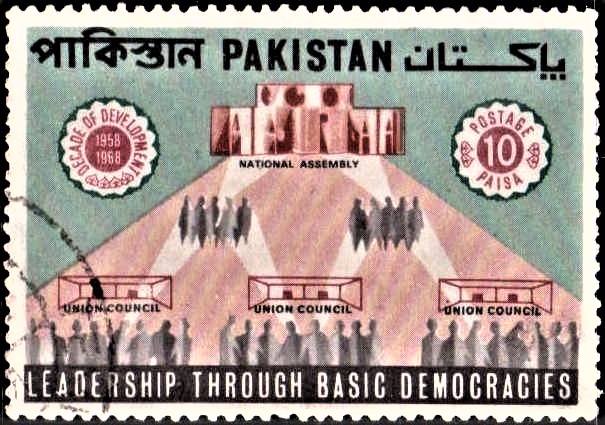
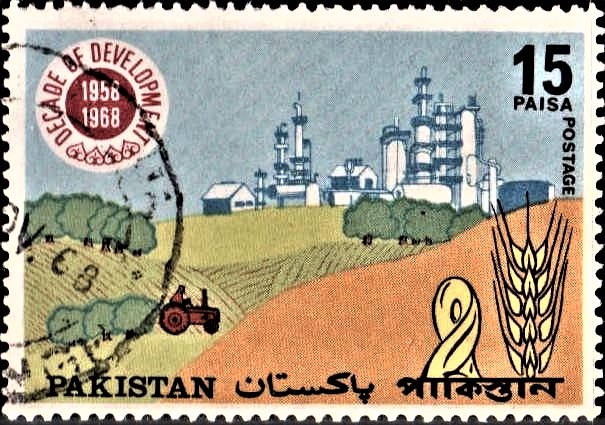
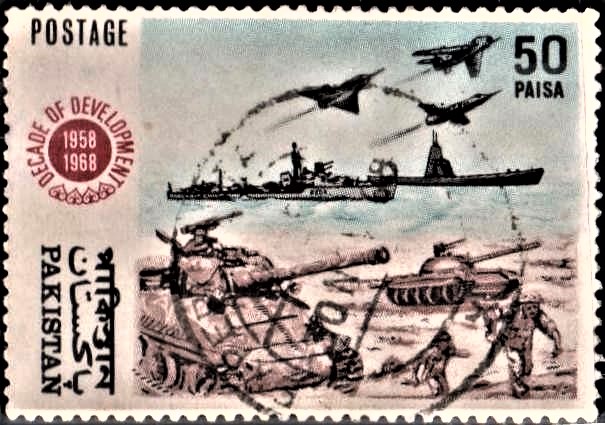
 Issued by Pakistan
Issued by Pakistan
Issued on Oct 27, 1968
Issued for : To celebrate the Decade of Development, the Pakistan Post Office is issuing a set of four stamps of 10, 15, 50 and 60 paisa denominations on the 27th October, 1968, on the following four aspects of development :–
(i) Political Reforms; (ii) Defence; (iii) Agriculture and Industry; (iv) Science and Culture.
Design :
10 Paisa (Political Reforms) The caption “Leadership through Basic Democracies” appear in the bottom black panel in reverse. Three groups of people are shown in front of Union Council Buildings indicated in simple red outline with ‘Union Council’ written in black underneath of each. Beyond this there are two smaller groups of people and further up there appears the proposed National Assembly Building in brick red colour. This whole thing forms a vista with the people in the forefront and the National Assembly Building at the other end. Rays of light representing delegation of powers are shown as emanating from the people and focussing on the National Assembly. The blank upper portion of the stamp on either side of the National Assembly Building is tinted in green with an ornamented circle on each side. The emblem of Decade of Development appears in the left circle and the denomination figure 10 with ‘paisa’ and ‘postage’ appears on the right in red colour. The word ‘Pakistan’ in Bengali, English and Urdu appears at top in black.
15 Paisa (Industrial and Agricultural Development) Industry is represented by a factory in the upper portion at the right hand side in ultramarine against the lighter background of the same colour. The lower portion depicts Agriculture. The left portion is in lush green and the lower right portion in chrome yellow colour. The green portion is subdivided in three tones of green – the top one is pale green with dark green trees at both ends, the middle portion represents cultivated land with red tractor and dark green trees at the bottom, the last portion is medium green representing a pasture. A corn of wheat and bundle of raw jute are shown in lemon yellow with black outline. Pakistan in English, Urdu and Bengali appears in black at the bottom. The denomination figure 15 appears in black with words ‘Paisa’ and ‘Postage’ beneath it. The symbol of Decade of Development appears in red in the white circle at top left corner.
50 Paisa (Defence) Defence being the subject it is represented by our three forces Army, Navy and Air Force. The space of the stamp is so divided that the subject of the stamp appears on 4/5th of the total space and the lettering and emblem of Decade of Development in the remaining 1/5th portion. In the upper blue portion at right three fighter planes (Mirage, F-104 and MIG-19) are shown. Sailing below is a modern destroyer and a submarine. In the foreground below appears in brown colour a Tank at the left corner. A Chinese tank is shown in the background. Two soldiers are shown climbing a bank. The denomination figure 50 appears at top right corner with ‘Paisa’ underneath the black colour. In the white panel which is 1/5th of the total space appears the word ‘Postage’ at top in black. The word Pakistan in Urdu Bengali and English also appears at the bottom in black but in a vertical position. The emblem of Decade of Development appears in red in between the above letterings.
60 Paisa (Scientific and Cultural Advancement) Science is represented by a factory and Atomic Reactor Building on the right hand side of stamp. Culture is represented by a Minaret Symbolic of modern Islamic architecture, contained within the arched window of the decorative panel at the left, which is after the style and colour scheme of Hala tiles. The panel, Minaret, factory and the Atomic Reactor building all appear in Mauve colour against Cobalt blue background. The symbol of Decade of Development appears in red colour in the white circle at the top on the right side of the decorative panel. The denomination figure 60 appears in the top right hand corner with words ‘Paisa’ and ‘Postage’ beneath it. The word ‘Pakistan’ in English, Urdu and Bengali appears in reverse in the red panel at the bottom.
Type : Stamps, Postal Used
Denomination : 10, 15, 50 & 60 Paisa
Colour :
10 Paisa – Turquoise green, scarlet, brick red and black
15 Paisa – Ultra marine, red, green and yellow
50 Paisa – Blue, brown, black and red
60 Paisa – Cobalt blue, mauve and red
Size of stamps : 50.8 x 35.2 mm.
Size of prints : 47.8 x 32.2 mm.
Perforation Gauge : 13 x 13 (c)
Quantities Printed : 10,00,000 pieces of each denomination
Number of stamps in each sheet : 50
Process of Printing : 10, 15 and 50 Paisa : Four colour Litho Offset and 60 Paisa three colour Litho Offset
Printers : The Pakistan Security Printing Corpn. Ltd., Karachi
About :
- Ten years is a very short period in the life of a nation, yet these few years of its twenty one years span are memorable for the striking progress achieved in different sectors of national life. Pakistan is now recognised as a model among the developing nations of the world.
- Political Reforms
- President Field Marshal Mohammad Ayub Khan has given the much-needed political stability to the country and this one factor alone has contributed enormously to the well being of the state and people. This he has achieved by giving a new Constitution to Pakistan. The system of Basic Democracies has ensured rural development and participation of the masses in national development programmes. The slogan “Leadership through Basic Democracies” has given a new life to the nation. 1,20,000 Basic Democrats elected on adult franchise basis now elect the President of Pakistan as well as members of the Provincial and National Assemblies, for a term of five years.
- Defence
- During the decade, the Pakistan Armed Forces have been reorganised in such a manner that despite its small size it can repel aggression from any quarter. The three arms of Pakistan forces have been equipped with modern weapons and recognizing the importance of the man behind the weapons the personnel also have been given intensive training. For training of officers separate academies for each service have been set up and provision has been made for specialisation in the technical branches of each service to ensure absolute efficiency in the operation of complicated weapons and equipment used in modern warfare. The service conditions of personnel have also been considerably improved to inspire confidence in the rank and file. The Defence services are now fully capable of guarding Pakistan’s land frontiers, shores and skies and to protect Pakistan’s commerce, fisheries and maritime rights in the Arabian sea and the Bay of Bengal.
- Agriculture and Industry
- Agriculture, neglected earlier, received high priority for development during this decade. To revolutionise agriculture, Land Reforms and Agricultural Reforms Commission were set up. In accordance with the recommendation of the Land Reforms Commission, 2.5 million acres of land were resumed from the absentee landlords and distributed among landless peasants. Large scale canal irrigation system has been developed and where this is not possible or found uneconomic, low-lift pumps have been installed as in Dinajpur district of East Pakistan for facilities of irrigation. To protect crops from the ravages of floods, embankment projects have been taken up. To save millions of acres of land from water-logging, reclamation projects have been undertaken in right earnest. Production of fertilizers has been stepped up. Of singular importance is the introduction of high-yielding crops – Mexi-Pak wheat and Irri rice – which are expected to bring self-sufficiency in food by 1970. Already West Pakistan has attained self-sufficiency in food crops.
- The Industrial sector has registered impressive growth due to incentives and facilities provided by the Government. As a result Pakistan has attained self-sufficiency in a larger number of consumer goods and some capital goods. Attention is now being diverted to the development of heavy and more sophisticated industries such as heavy engineering, electrical equipment, machine tools and petro-chemicals, etc. From a few cotton mills in 1958 the number has grown to 150, employing 200,000 workers. The cotton industry presently produces about 550 million lbs. of yarn and about 800 million yards of cotton cloth annually. There are 32 jute mills. The existing mills produce about 4 lakh tons of jute goods earning over Rs. 580 million annually. The Karachi Shipyard has been remodelled to undertake ship-building and repair facilities. It has already built a 12,000 ton ocean-going ship “Al-Abbas”. The first steel mill in Pakistan has gone into production in Chittagong and three more are being set up.
- Science and Culture
- Scientific education as well as cultural advancement had been sadly neglected in the past. President Ayub set up Commissions for Scientific Research, Education and Sports and Culture. Government gave due considerations to recommendations of the Commission. The results have been spectacular. In 1960 the estimated number of scientists were only 300. Today Pakistan has about 1200 scientists engaged in Research in agriculture, medicine and industrial production. A National Science Council has been established to co-ordinate research work.
- A revolution has been brought about in education by changing the old lopsided system which had neglected scientific outlook on education. More attention is now being given to produce scientists and technicians. Number of educational institutions and enrolment have increased several fold. There are now 12 Universities, including two Engineering and two Agricultural, which were set up in 1961. Number of Scholarships has been increased. Boards and Academies for advancement of regional languages have been set up to promote them and awards for best literary works are given. During the last ten years sports has been put up on a sound basis to ensure that talent shall get all the opportunities it needs and to raise the all-round standard of skill, a Sports Control Board has been formed.
- In short, the last decade has seen nationwide activities in all sectors and with the country’s reoriented policy on Foreign affairs, a new generation with a new outlook on both national and international affairs and development has been born. Pakistan is now on the sure road to progress and prosperity.
- Issued by the Director-General, Pakistan Post Office, Karachi.


